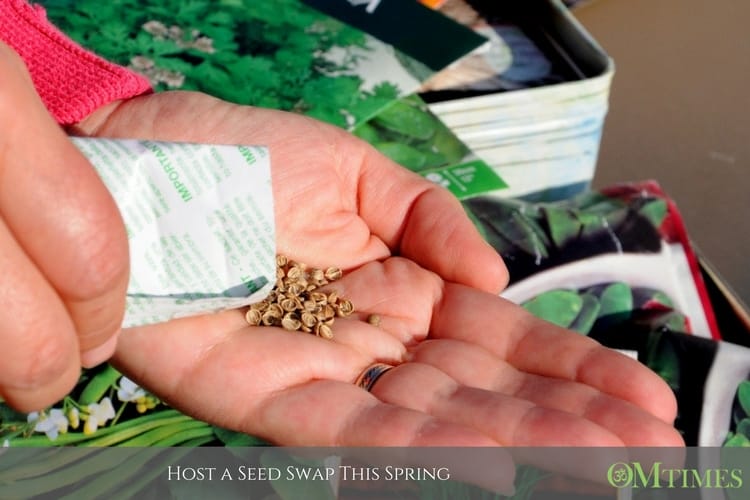Host a Seed Swap This Spring

A seed swap is a great way to learn about local seeds, build a community around seed sharing, and show support for the Save Seed Sharing movement. Designed for gardening newbies and master gardeners alike, they provide people an opportunity to get seeds from other local growers and share seeds from their own harvest.
How to Host a Seed Swap
By Cat Johnson As Rebecca Newburn, founder and co-coordinator of the Richmond Grows Seed Lending Library explains, seed swaps are fun ways to collect seeds that are more climate resilient and adapted to local soils than commercial seeds, they’re great community events, they provide an opportunity to exchange gardening tips and meet other gardeners.
As Rebecca Newburn, founder and co-coordinator of the Richmond Grows Seed Lending Library explains, seed swaps are fun ways to collect seeds that are more climate resilient and adapted to local soils than commercial seeds, they’re great community events, they provide an opportunity to exchange gardening tips and meet other gardeners.
To host a seed swap, you’ll need space, tables, volunteers, seeds to share, a few supplies, signage, flyers and other communication materials, and a group of enthusiastic seed sharers. The following tips are taken from a seed swap guide created by the Richmond Grows Seed Lending Library.
Seed swap tables should be clearly noted which seeds are present and their difficulty level
Before the Seed Swap
Gather Volunteers:
For a successful seed swap, you’ll need a team of volunteers to help with creating and distributing flyers and information about the event, reaching out to media contacts, connecting with partners and aligned organizations. They will be making signs for use at the event, setting up tables and signage at the event, staffing tables and directing people at the swap, and helping with cleanup after the event.
You’ll want a few experts on-hand, however, to teach people about saving seeds and offer gardening tips.
Collect Seeds to Share: If your swap is affiliated with a seed library, you may have enough seeds to get started. If not, reach out to gardening associations, master gardeners, local seed savers, horticulture departments or botanical gardens to request seed donations.
Promote the Event: Promoting your seed swap is essential. The following promotional tools will get you started, but tap into any resources your community may have: Posters, Small flyers, and handbills
Media: local television, radio, blogs, newspapers, weekly papers, etc. Note: media outlets generally need plenty of notice to schedule coverage of events of this type.
Social media start promoting the event as soon as it’s confirmed and increase your social media campaign as you get closer to the event. Ask partners and aligned organizations and businesses to promote the event through their social media channels as well.
Swap Signage: At the event, you’ll need signs introducing people to the seed swap, detailing which plants are good for new gardeners and which are for more advanced gardeners. Also Include information on the local seed library (if there is one), instructions on taking and sharing seeds, a guide to local planting times. The Fedco seed saving chart, recommendations how many seeds to take for the amount of plants you want to end up with, and any other information you’d like to share.
At their seed swaps, Richmond Grows color codes the seed envelopes. Super easy seeds have green labels, easy is blue, and difficult is yellow. “Borrower Beware” signs denoting expert-level plants, are orange.
Event Supplies and Materials: Letter-sized envelopes can be used as seed packets. Seal and tape the ends and cut them in half to create packets people can use to carry seeds home. You may be able to get business envelopes donated from companies who are going out of business or changing addresses, or from printer errors.
Poster paper is great for making signs for wayfinding and swap instructions
If your swap is associated with a seed library or organization, bring a rubber stamp with library information and stamp pad. That way you can stamp seed packets with information.
Bring masking tape for hanging posters
Bring lots of pencils for tables. Richmond Grows suggests taping artificial flowers on the ends to identify them as belonging to the swap and keep them from disappearing.
Bring staplers or tape for people to seal their seed envelopes
For your swap, you may want to create a How to Save Seeds brochure in English [doc] and Spanish [doc] to give out so people can bring seeds from their harvest to the next swap. Richmond Grows invites seed swap hosts to put your own contact info on their brochures. Also, see 9 Ways to Power Up the Seed Movement.
If your seed swap is in conjunction with a seed library or community organization, bring membership forms or an email signup list. Get participants’ contact information so you can alert them about future events.
Collecting Seeds: In addition to giving out seeds, you’ll be collecting seeds as well. Here are some tips for keeping collected seeds organized:
Use pre-stamped envelopes for seed donations, with labels in English and Spanish
Use rubber bands to organize seeds packets at the end of the event—for instance, collect all tomato seeds together
Bring bags or boxes to put seeds in at the end of the event
At each table, note whether the seeds are super easy, easy, or hard. Create a system for noting which seeds are for edibles, non-edible, medicinal and cooking herbs, and hybrids. With hybrid seeds, be sure to note that hybrids will not produce plants like their parents and that seeds should not be saved for the library. Richmond Grows does this by placing a yellow dot sticker on hybrid seed packets.
At the Seed Swap
Orientation: Do a mini-orientation to the library, and seed swap before people are allowed to take any seeds. This should take about 10 minutes. Repeat the orientation throughout the event.
Give Thanks: Newburn suggests that, if it’s appropriate for your community, a blessing or moment of gratitude for the seeds and the community is “a lovely way to start a swap.”
Volunteers: Volunteers should be available to answer questions and direct people to the various tables at the swap. Have people on table duty who can answer questions. Have name tags for volunteers with identifiers such as “seed saver” or “ask me about the seed library.”
Encourage First-Timers to Take Seeds: Make people feel welcome even if they don’t have any seeds to share yet. The Bay Area Seed Interchange (BASIL) in Berkeley asks people to bring seed to share and a potluck dish or $10, but no one is turned away for lack of funds or seeds.
Encourage people to take what they intend to grow and label everything so when they bring back seeds, it’s clear what they are. Also, encourage people to learn about saving seeds—in particular, the super easy seeds such as tomatoes, beans, peas, and lettuce. This can be facilitated by brochures and volunteers.
If your seed swap is affiliated with a seed library, give regular tours of the library throughout the event. Photo: Richmond Grows Seed Lending Library
Promote Seed Saving: Make sure folks understand that this is not just a taking event and that the intention of the swap includes creating local resilience around food and seeds. The thing you can do to promote this:
Start the swap by explaining that seeds are labeled by seed saving level and that you are encouraging everyone to start with the super easy plants.
Have plenty of super easy seed saving brochures available.
Have people who are experienced seed savers wear a badge that says, “Ask me about seed saving.”
Let folks know that there are people who can answer questions about seed saving.
Have a class, at or before the swap, about seed saving.
Clean Up: Make sure volunteers stick around to help clean up, take notes on what you can do to improve the event for next time, and bundle remaining seeds to go to your local seed library.
Helpful Tips from Richmond Grows
Make sure you have lots of envelopes for folks to write info on. Richmond Grows has stamp they use to pre-stamp hundreds of envelopes before the event to encourage people to write quality information on the seeds they take with them.
If you have a web presence, or if you’re emailing folks about the event, you may also want to have them be able to download labels so they can bring in well-labeled seeds to share.
To learn more about hosting a seed swap, see Richmond Grows Seed Lending Library’s seed swap guide. Be sure to sign the Save Seed Sharing petition to show your support and receive updates about the seed sharing movement.
You will also enjoy What’s So Special About New Beginnings?
About Richmond Grows
Richmond Grows is a non-profit seed lending library located in the public library in Richmond, California. richmondgrowsseeds.org
Follow @CatJohnson on Twitter
OMTimes Magazine is one of the leading on-line content providers of positivity, wellness and personal empowerment. OMTimes Magazine - Co-Creating a More Conscious Reality




